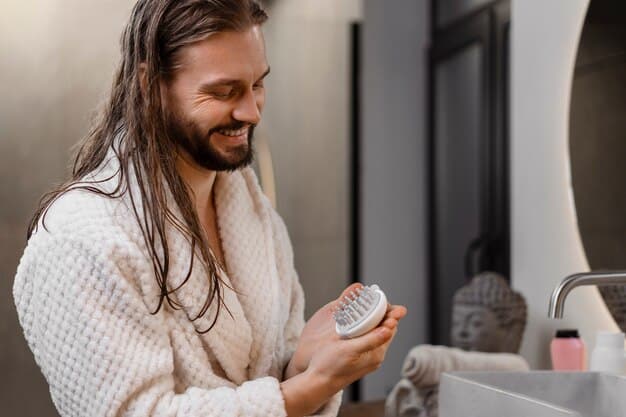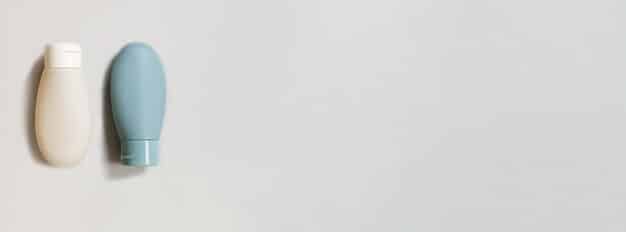Men’s Oily Skin: Control Shine & Prevent Breakouts

Achieving clear, balanced skin for men with oily complexions requires a strategic approach focusing on consistent cleansing, targeted treatment, and adequate hydration to manage excess sebum, minimize pores, and prevent acne breakouts effectively.
Navigating the world of skincare can feel daunting, especially for men grappling with oily skin. Beyond the occasional shine, excess oil often leads to enlarged pores, blackheads, and relentless breakouts, making it crucial to find routines that genuinely work. This comprehensive guide unveils The 3 Best Men’s Skincare Routines for Oily Skin: Control Shine and Prevent Breakouts, offering actionable strategies to transform your complexion.
Understanding Oily Skin in Men: More Than Just Shine
Oily skin isn’t just about a shiny forehead; it’s a specific skin type characterized by an overproduction of sebum, the natural oil produced by our sebaceous glands. While sebum is essential for keeping skin hydrated and protected, an excess can lead to a cascade of common issues, from a perpetually greasy appearance to persistent acne. Understanding the root causes is the first step toward effective management.
Several factors contribute to oily skin in men, ranging from genetics and hormonal fluctuations, particularly elevated testosterone levels, to environmental influences like humidity and stress. Diet, though often debated, can also play a role for some individuals. The common misconception is that oily skin doesn’t need moisturizer, which couldn’t be further from the truth. Dehydrating the skin can paradoxically trigger more oil production as the skin attempts to compensate.
The Science Behind Sebum Overproduction
The sebaceous glands are more abundant and often larger in men, especially on the face, chest, and back. Androgens, primarily testosterone, stimulate these glands to produce more sebum. This explains why teenagers, with their fluctuating hormone levels, often experience significant oily skin issues. However, oily skin can persist into adulthood due to genetic predisposition or ongoing hormonal imbalances.
When excess sebum mixes with dead skin cells and environmental debris, it can clog pores. These clogged pores become breeding grounds for bacteria, specifically Propionibacterium acnes (P. acnes), leading to inflammation and breakouts. Consequently, managing oily skin isn’t just about shine control; it’s about creating an environment where skin can thrive without congestion and inflammation.
Key indicators of oily skin include:
- A noticeable shine, particularly in the T-zone (forehead, nose, chin).
- Enlarged or visible pores.
- Frequent blackheads, whiteheads, and pimples.
- Makeup (if applicable) sliding off easily or looking “muddy.”
Addressing these symptoms effectively requires a consistent and disciplined approach, focusing on products that regulate oil without stripping the skin of its essential moisture. This balance is crucial for long-term skin health and clarity, leading us to tailor routines that truly address men’s unique needs.
Routine 1: The Essentialist – Simple & Effective for Beginners
For men new to skincare or those seeking a minimalist yet effective approach, the Essentialist routine prioritizes core steps to control oil and prevent breakouts without overwhelming the user. This routine focuses on consistency and the right product choices, proving that less can genuinely be more when it comes to managing an oily complexion. It’s about establishing fundamental habits that yield noticeable results.
The beauty of this routine lies in its simplicity, making it easy to incorporate into any daily schedule. No complicated layering, no extensive product lists – just straightforward steps designed to clean, treat, and protect. This foundation is crucial for those who might otherwise be deterred by complex skincare regimens, ensuring adherence and encouraging long-term positive habits for healthier skin.
Step-by-Step Breakdown:
- Morning:
- Cleanse: Start with a gentle foaming or gel cleanser formulated for oily skin. Look for ingredients like salicylic acid (BHA) to deep clean pores or niacinamide to help regulate sebum. Use lukewarm water to rinse.
- Moisturize: Apply a lightweight, oil-free moisturizer, preferably one with SPF 30 or higher. This hydrates without adding grease and protects against sun damage, which can exacerbate oiliness.
- Evening:
- Cleanse: Repeat the cleansing step to remove accumulated oil, dirt, and impurities from the day.
- Treat (Optional but Recommended): If breakouts are a concern, apply a targeted treatment. A salicylic acid serum or a spot treatment with benzoyl peroxide can be beneficial.
- Moisturize: Use the same lightweight, oil-free moisturizer. Evening hydration is vital for skin repair and balance overnight.
The key to the Essentialist routine’s success is consistency. Performing these steps daily, both morning and night, allows the skin to adjust and respond to the active ingredients. Over time, you should observe a significant reduction in shine and fewer breakouts, leading to a clearer and more balanced complexion. This routine is the perfect starting point before exploring more advanced treatments.
Product selection is paramount for this routine. Opt for non-comedogenic formulas, which means they won’t clog pores. Gel-based or water-based products are often best suited for oily skin as they are quickly absorbed and feel lighter. Avoid heavy creams or products with occlusive ingredients that can trap oil and lead to further congestion.
Routine 2: The Advanced Balancer – Targeted & Refined for Persistent Issues
For men who have mastered the basics but still struggle with persistent oiliness, enlarged pores, and recurring breakouts, the Advanced Balancer routine offers a more comprehensive and refined approach. This tier introduces additional targeted treatments and incorporates ingredients known for their efficacy in sebum regulation and pore refinement. It’s about elevating your skincare game to achieve truly balanced and clear skin.
This routine recognizes that while fundamental steps are crucial, some skin concerns require specialized attention. By integrating potent actives and strategic steps, the Advanced Balancer routine aims to not only control current issues but also to improve overall skin texture and resilience, minimizing future problems. This involves carefully layering products for maximum benefit.

Incorporating Active Ingredients:
The Advanced Balancer routine builds upon the Essentialist framework by adding products with higher concentrations of active ingredients or introducing new steps. This careful progression allows the skin to adapt without irritation, ensuring optimal results for those dealing with more stubborn oily skin concerns.
Exfoliation is Key: Regular, gentle exfoliation is critical for oily skin. Chemical exfoliants like Beta-Hydroxy Acids (BHAs), primarily salicylic acid, are highly effective. They are oil-soluble, allowing them to penetrate deep into pores to dissolve sebum and dead skin cells, preventing blockages. Alpha-Hydroxy Acids (AHAs), such as glycolic or lactic acid, work on the skin’s surface to gently slough off dead cells, improving texture and brightness.
Morning Routine Enhancements:
- Cleanse: Use a salicylic acid-based cleanser to deeply purify pores.
- Toner (Optional but Recommended): A non-drying toner with witch hazel, niacinamide, or a mild BHA can help rebalance skin pH and prep it for subsequent treatments.
- Antioxidant Serum: A lightweight Vitamin C serum can protect skin from environmental damage, brighten complexion, and help regulate oil production over time.
- Moisturizer with SPF: Continue with an oil-free, mattifying moisturizer containing SPF 30+.
Evening Routine Enhancements:
- Double Cleanse: Start with an oil cleanser or micellar water to dissolve makeup, sunscreen, and excess sebum, followed by your regular gel or foaming cleanser. This ensures a thorough clean without stripping.
- Exfoliating Treatment: 2-3 times a week, apply a leave-on BHA or AHA liquid exfoliant. For sensitive skin, start with 1-2 times a week.
- Targeted Serum: A niacinamide serum (5-10%) is excellent for regulating oil, reducing inflammation, and minimizing pore appearance. Alternatively, a retinol serum (start with a low concentration 2-3 times a week) can be introduced to accelerate cell turnover, reduce breakouts, and improve skin texture.
- Lightweight Moisturizer: Finish with a non-comedogenic, oil-free moisturizer.
This advanced routine requires a more discerning eye when selecting products. Look for formulation synergy, ensuring that active ingredients don’t conflict or cause excessive irritation when used together. Patch testing new products is always recommended, especially when introducing powerful actives like retinoids or higher concentrations of acids.
The Advanced Balancer routine focuses on providing proactive solutions to moderate and severe oily skin concerns. By maintaining consistency and carefully monitoring skin’s response, individuals can achieve significant improvements in shine control, pore reduction, and overall clarity, moving towards a much healthier skin barrier.
Routine 3: The Holistic Defender – Comprehensive & Preventative for Long-Term Health
The Holistic Defender routine extends beyond topical treatments, integrating lifestyle adjustments and specialized care to address oily skin from multiple angles. This comprehensive approach is designed for men committed to long-term skin health, not just immediate symptom management. It’s about creating a sustainable environment for balanced skin, minimizing future issues, and enhancing overall well-being. This routine acknowledges that skin health is intertwined with general health.
For those who have seen progress with the Essentialist and Advanced Balancer routines but seek to optimize their results and embed habits that support sustained clarity, the Holistic Defender is the ultimate strategy. It involves a deeper commitment to understanding skin’s needs and responding with both external care and internal support. This routine emphasizes preventative measures as much as proactive treatment, acknowledging the interplay between internal and external factors.
Beyond the Daily Skincare Steps:
This routine complements diligent skincare with lifestyle considerations that can significantly impact sebum production and overall skin health. It underscores the idea that a truly effective skincare regimen extends beyond the bathroom counter, encompassing diet, stress management, and even sleep quality. Each of these elements contributes to skin’s ability to regulate itself and combat issues like excess oil and breakouts.
Dietary Considerations: While direct links are still under research, anecdotal evidence and some studies suggest certain foods can influence skin. Consider reducing high-glycemic index foods (sugary snacks, refined carbs) and dairy, which anecdotally trigger breakouts in some individuals. Instead, emphasize a diet rich in:
- Omega-3 fatty acids (flaxseed, chia seeds, fatty fish) for anti-inflammatory benefits.
- Antioxidants (berries, leafy greens) to protect against oxidative stress.
- Zinc (nuts, seeds, legumes) which plays a role in immunity and inflammation.
Stress Management: Chronic stress can elevate cortisol levels, which in turn can stimulate sebaceous glands to produce more oil. Incorporating stress-reducing practices can indirectly benefit your skin. These might include:
- Regular exercise.
- Meditation or mindfulness.
- Adequate sleep (7-9 hours per night).
Hydration: Paradoxically, dehydrated skin can produce more oil. Ensure you’re drinking plenty of water throughout the day to support overall skin function and maintain proper hydratiion. This helps prevent the skin from overcompensating for a lack of moisture.
Regular Pillowcase Changes: Your pillowcase can accumulate oil, dead skin cells, and bacteria, transferring them back to your face each night. Changing your pillowcase 2-3 times a week can significantly reduce environmental factors contributing to breakouts, ensuring a cleaner sleeping surface.
Professional Treatments: Consider incorporating periodic professional treatments such as:
- Facials: Regular deep-cleansing facials can help extract clogged pores and provide professional-grade exfoliation.
- Chemical peels: Administered by a professional, these can provide deeper exfoliation and address textural issues and stubborn breakouts.
- Blue light therapy: Can target acne-causing bacteria and reduce inflammation.
The Holistic Defender routine embraces an integrated view of skin health, recognizing that consistent topical care combined with a healthy lifestyle creates the most resilient and balanced complexion. This long-term commitment results in not just clearer skin but an overall sense of well-being, making it the ultimate destination for managing oily skin.
Essential Ingredients for Oily Skin: A Deep Dive
Choosing the right ingredients is paramount in any skincare routine for oily skin. Not all ingredients are created equal, and some are particularly effective in combating excess sebum, minimizing pores, and preventing breakouts. Understanding these key players allows for informed product selection, ensuring your routine delivers the best possible results. These ingredients often work symbiotically, enhancing each other’s effects.
The efficacy of a product often hinges on the concentration and quality of its active ingredients. Researching and understanding what these components do can demystify product labels and empower you to make choices that truly align with your skin’s needs. This section provides a concise overview of the most impactful ingredients, offering insights into their mechanisms of action and benefits for oily skin types.
Must-Have Actives and Their Benefits:
When selecting products for an oily skin routine, keeping an eye out for these ingredients will significantly improve your chances of success. They are widely recognized by dermatologists and offer distinct advantages for managing oil and associated concerns.

- Salicylic Acid (BHA): This is perhaps the most celebrated ingredient for oily and acne-prone skin. As a beta-hydroxy acid, it is oil-soluble, meaning it can penetrate through sebum into the pore lining to dissolve dead skin cells and excess oil, preventing and clearing blackheads and whiteheads. It also has anti-inflammatory properties, making it excellent for reducing redness associated with breakouts.
- Benefits: Exfoliates within the pore, reduces oil, prevents acne, calms inflammation.
- Found in: Cleansers, toners, serums, spot treatments.
- Niacinamide (Vitamin B3): A powerhouse ingredient with multiple benefits for oily skin. Niacinamide can help regulate sebum production, reduce the appearance of enlarged pores, improve skin barrier function, and calm redness and inflammation. It’s gentle and well-tolerated by most skin types, including sensitive skin.
- Benefits: Regulates sebum, minimizes pore appearance, strengthens barrier, reduces redness.
- Found in: Serums, moisturizers.
- Benzoyl Peroxide: An effective treatment for inflammatory acne. It works by killing acne-causing bacteria (P. acnes) on the skin’s surface and helps to shed dead skin cells. While powerful, it can be drying, so starting with a lower concentration and moisturizing well is crucial.
- Benefits: Kills acne bacteria, clears pores.
- Found in: Cleansers, spot treatments.
- Retinoids (Retinol, Adapalene): Derivatives of Vitamin A, retinoids accelerate cell turnover, preventing pores from becoming clogged. They are highly effective in treating and preventing acne, reducing pore size (indirectly, by keeping them clear), and improving overall skin texture. Start with a low strength and use gradually to avoid irritation.
- Benefits: Increases cell turnover, prevents clogged pores, reduces acne, refines texture.
- Found in: Serums, creams.
- Hyaluronic Acid: While oily skin produces excess oil, it can still be dehydrated. Hyaluronic acid is a humectant that draws moisture from the air into the skin without adding oil, ensuring skin stays hydrated and balanced. This prevents the skin from overcompensating by producing more oil.
- Benefits: Hydrates without oiliness, maintains skin barrier.
- Found in: Serums, lightweight moisturizers.
By carefully incorporating these ingredients into your routine, men can create a powerful defense against the challenges of oily skin, leading to a clearer, healthier, and more balanced complexion. Always remember to patch test new products and consult with a dermatologist if you have severe or persistent skin concerns.
Common Pitfalls & How to Avoid Them
Even with the best intentions and products, men often fall into common traps when managing oily skin, inadvertently making their condition worse. Recognizing these pitfalls is as important as knowing the right steps, as preventing mistakes can accelerate your progress towards a clear and balanced complexion. Awareness is the first step toward avoiding counterproductive habits that can undermine your skincare efforts.
Managing oily skin is not just about what you apply, but also how you approach your daily habits and product usage. Misconceptions and aggressive tactics can strip the skin, leading to a vicious cycle of increased oil production and persistent issues. This section highlights the most common errors and provides actionable advice on how to steer clear of them, ensuring your routine is truly beneficial and not detrimental.
Mistakes That Exacerbate Oily Skin:
Avoiding these common errors can significantly improve your oily skin condition and allow your chosen routine to work more effectively. Careful attention to these details can make a significant difference in your skincare journey.
- Over-Cleansing or Using Harsh Cleansers: This is arguably the most common mistake. While it might seem logical to scrub away excess oil, harsh cleansers (especially those with sulfates or strong detergents) or excessive washing can strip the skin of its natural oils. This dehydration can then trigger the sebaceous glands to produce even more oil to compensate, leading to a rebound effect and making oiliness worse.
- Solution: Stick to gentle, foaming or gel cleansers twice a day (morning and night), even if your skin feels oily.
- Skipping Moisturizer: Many men with oily skin believe moisturizer will make their skin greasier. This is a myth. Dehydrated skin often produces more oil as it tries to rebalance itself. Skipping moisturizer can lead to a compromised skin barrier and increased oil production.
- Solution: Always use a lightweight, oil-free, non-comedogenic moisturizer, even if your skin is oily. Look for gel or water-based formulas.
- Using Alcohol-Based Toners: While they might give a temporary feeling of “cleanliness” and tightness, alcohol-heavy toners are incredibly drying. Similar to harsh cleansers, they strip the skin’s moisture, leading to reactionary oil production and potential irritation.
- Solution: Opt for alcohol-free toners with beneficial ingredients like niacinamide or witch hazel.
- Picking at Pimples/Touching Face Frequently: This habit can introduce bacteria from your hands to your face, spread existing bacteria, and cause inflammation, scarring, and hyperpigmentation. Furthermore, constant touching can stimulate oil glands.
- Solution: Resist the urge to pick. Use targeted spot treatments, and be mindful of how often you touch your face throughout the day.
- Not Using Sunscreen: Sun exposure can damage the skin barrier, leading to increased oil production and potential hyperpigmentation from breakouts. Some sunscreens can feel heavy, but neglecting SPF is detrimental.
- Solution: Choose a broad-spectrum, oil-free, mattifying sunscreen (or a moisturizer with SPF) daily. Mineral sunscreens with zinc oxide or titanium dioxide can sometimes offer a matte finish.
By being mindful of these common missteps and adjusting your habits accordingly, you can actively support your skin’s health and enhance the effectiveness of your chosen skincare routine. Patience and consistency in avoiding these pitfalls are key to achieving lasting results and maintaining a balanced, shine-free complexion.
Customizing Your Routine: Listen to Your Skin
While the routines outlined provide a solid framework, the most effective skincare plan is always one that is customized to your individual needs. Skin is dynamic; it responds to changes in environment, diet, stress levels, and even age. Therefore, listening intently to your skin’s signals and adjusting your routine accordingly is crucial for sustained success. What works for one person may not work for another, and what works today might need tweaking tomorrow.
The journey to balanced skin is ongoing, and it’s essential to approach it with flexibility and a willingness to adapt. This involves attentive observation of how your skin reacts to products, environmental factors, and lifestyle choices. Customization isn’t about trial and error in a haphazard way; it’s about informed adjustments based on your skin’s evolving condition, ensuring long-term health and clarity.
How to Adapt and Personalize:
Personalizing your routine means recognizing that skincare is not a one-size-fits-all solution. It’s about becoming an expert on your own skin, understanding its unique tendencies and fluctuations, and refining your approach based on real-time feedback. This responsiveness enables you to maintain optimal skin health, even as external and internal conditions change.
- Start Slow with New Products: When introducing a new active ingredient or a product, incorporate it one at a time. This allows you to pinpoint any adverse reactions or sensitivities. Start with lower concentrations and less frequent use, gradually increasing as your skin adapts. This ‘patch test’ approach minimizes irritation.
- Observe Seasonal Changes: Your skin’s oil production may fluctuate with the seasons. In warmer, more humid months, you might need lighter moisturizers and more aggressive oil control. During colder, drier periods, your skin might benefit from slightly richer (but still non-comedogenic) hydration to counteract dryness and prevent compensatory oiliness.
- Monitor Your Diet & Lifestyle: Pay attention to whether certain foods, stress levels, or lack of sleep seem to trigger breakouts or increase oiliness. While not universally applicable, identifying personal triggers can help you make informed lifestyle adjustments that support your skin.
- Consult a Professional: If you’re experiencing severe or persistent issues (e.g., cystic acne, extreme oiliness that doesn’t respond to over-the-counter products), consult a dermatologist. They can provide personalized advice, prescribe stronger medications, or recommend professional treatments that are tailored to your specific skin concerns.
- Adjust for Activity Levels: If you exercise frequently, ensure you cleanse your face immediately after your workout to remove sweat and oil, which can otherwise clog pores. A quick rinse or a gentle wipe can prevent post-workout breakouts.
- Listen to Sensations: Pay attention to how your skin feels. If it feels tight, flaky, or overly dry, you might be over-treating it or using products that are too harsh. If it still feels excessively oily after cleansing and moisturizing, you might need to adjust your oil-controlling products.
Customizing your routine is an ongoing process of observation, experimentation, and refinement. By remaining attuned to your skin’s needs and being willing to make adjustments, you empower yourself to achieve and maintain a healthy, balanced, and confident complexion. This dynamic approach ensures that your skincare regimen remains effective and supportive throughout your life.
| Key Point | Brief Description |
|---|---|
| 🧼 Essentialist Routine | Simple, 3-step AM/PM routine for beginners: cleanse, moisturize (with SPF). Focus on consistency. |
| 🔬 Advanced Balancer | Adds targeted treatments like salicylic acid, niacinamide, & retinoids for persistent oil/acne. |
| 🌿 Holistic Defender | Combines skincare with lifestyle changes (diet, stress, sleep) and professional treatments. |
| 🧪 Key Ingredients | Salicylic Acid, Niacinamide, Benzoyl Peroxide, Retinoids, Hyaluronic Acid are crucial for oily skin. |
Frequently Asked Questions About Men’s Oily Skin
Men typically have larger sebaceous glands and higher testosterone levels, which stimulate more sebum production. This hormonal influence, coupled with a generally thicker skin texture and larger pores, contributes to men often experiencing oilier skin compared to women.
No, skipping moisturizer can actually make oily skin worse. When skin becomes dehydrated, it often overcompensates by producing more oil. Using a lightweight, oil-free, non-comedogenic moisturizer helps balance hydration without adding grease, preventing this rebound effect.
It is generally recommended to cleanse your face twice daily: once in the morning and once in the evening. Over-cleansing or using harsh cleansers can strip the skin of its natural oils, leading to irritation and potentially triggering more oil production.
While the direct link is still debated, some studies and anecdotal evidence suggest that high-glycemic index foods (like refined sugars) and dairy can influence breakouts and oiliness in some individuals. Focusing on a balanced diet rich in antioxidants and healthy fats may help.
You should consult a dermatologist if your oily skin is severe, doesn’t respond to over-the-counter products, or is accompanied by persistent, painful cystic acne. A professional can offer prescription treatments, in-office procedures, and personalized advice.
Conclusion
Mastering oily skin is an achievable goal for any man willing to embrace a consistent and targeted skincare routine. From the foundational steps of the Essentialist routine to the advanced treatments and holistic lifestyle adjustments, success lies in understanding your skin’s unique needs and responding with informed choices. By integrating key ingredients, avoiding common pitfalls, and diligently customizing your regimen, you can control shine, prevent breakouts, and foster a healthier, more confident complexion. Ultimately, robust skin health is within reach for those who approach their care with diligence and patience, transforming oily skin from a challenge into a manageable characteristic.





